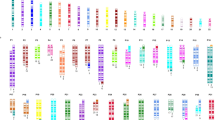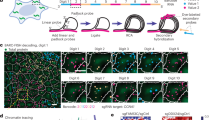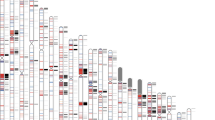Abstract
Large-scale copy number variation that is cytogenetically visible in normal individuals has been described as euchromatic variation but needs to be distinguished from pathogenic euchromatic deletion or duplication. Here, we report eight patients (three families and two individuals) with interstitial deletions of 9q13–q21.12. Fluorescence in situ hybridisation with a large panel of BACs showed that all the deleted clones were from extensive tracts of segmentally duplicated euchromatin, copies of which map to both the long and short arms of chromosome 9. The variety of reasons for which these patients were ascertained, and the phenotypically normal parents, indicates that this is a novel euchromatic variant with no phenotypic effect. Further, four patients with classical euchromatic variants of 9q12/qh or 9p12 were also shown to have duplications or triplications of this segmentally duplicated material common to both 9p and 9q. The cytogenetic boundaries between the segmentally duplicated regions and flanking unique sequences were mapped to 9p13.1 in the short arm (BAC RP11-402N8 at 38.7 Mb) and to 9q21.12 in the long arm (BAC RP11-88I18 at 70.3 Mb). The BACs identified in this study should in future make it possible to differentiate between clinically significant deletions or duplications and euchromatic variants with no established phenotypic consequences.
Similar content being viewed by others
Log in or create a free account to read this content
Gain free access to this article, as well as selected content from this journal and more on nature.com
or
Accession codes
References
Eichler EE : Recent duplication, domain accretion and the dynamic mutation of the human genome. Trends Genet 2001; 17: 661–669.
Sebat J, Lakshmi B, Troge J et al: Large-scale copy number polymorphism in the human genome. Science 2004; 305: 525–528.
Iafrate AJ, Feuk L, Rivera MN et al: Detection of large-scale variation in the human genome. Nat Genet 2004; 36: 949–951.
Sharp AJ, Locke DP, McGrath SD et al: Segmental duplications and copy-number variation in the human genome. Am J Hum Genet 2005; 77: 78–88.
Park JP, Wojiski SA, Spellman RA, Rhodes CH, Mohandas TK : Human chromosome 9 pericentric homologies: implications for chromosome 9 heteromorphisms. Cytogenet Cell Genet 1998; 82: 192–194.
Starke H, Seidel J, Henn W et al: Homologous sequences at human chromosome 9 bands p12 and q13–21.1 are involved in different patterns of pericentric rearrangements. Eur J Hum Genet 2002; 12: 790–800.
Humphray SJ, Oliver K, Hunt AR et al: DNA sequence and analysis of human chromosome 9. Nature 2004; 429: 369–374.
Barber JC : Directly transmitted unbalanced chromosome abnormalities and euchromatic variants. J Med Genet 2005; 42: 609–629.
Buckton KE, O'Riordan ML, Ratcliffe S, Slight J, Mitchell M, McBeath S : A G-band study of chromosomes in liveborn infants. Ann Hum Genet 1980; 43: 227–239.
Di Giacomo MC, Cesarano C, Bukvic N, Manisali E, Guanti G, Susca F : Duplication of 9 p11.2–p13.1: a benign cytogenetic variant. Prenat Diagn 2004; 24: 619–622.
Lecce R, Murdolo M, Gelli G et al: The euchromatic 9p+ polymorphism is a locus-specific amplification caused by repeated copies of a small DNA segment mapping within 9p12. Hum Genet 2006; 118: 760–766.
Madan K : An extra band in human 9qh+ chromosomes. Hum Genet 1978; 43: 259–264.
Berg JM, Gardner HA, Gardner RJM et al: Dic(21;21) in a Down syndrome child with an unusual chromosome 9 variant band. J Med Genet 1980; 17: 144–148.
Docherty Z, Hulten MA : Extra euchromatic band in the qh region of chromosome 9. J Med Genet 1985; 22: 156–157.
Roland B, Cox DM, Hoar DI, Fowlow SB, Robertson AS : A familial interstitial deletion of the long arm of chromosome 21. Clin Genet 1990; 37: 423–428.
Docherty Z, Hulten MA : Rare variant of chromosome 9. Am J Med Genet 1993; 45: 105–106.
Jalal SM, Kukolich MK, Garcia M, Day DW : Euchromatic 9q+ heteromorphism in a family. Am J Med Genet 1990; 37: 155–156.
Knight LA, Soon MG, Tan M : Extra positive band on the long arm of chromosome 9. J Med Genet 1995; 32: 994–995.
Reddy KS : Variants of chromosome 9 with additional euchromatic bands: two case reports. Am J Med Genet 1996; 64: 536–538.
Fan Y, Linardopoulou E, Friedman C, Williams E, Trask BJ : Genomic structure and evolution of the ancestral chromosome fusion site in 2q13–2q14.1 and paralogous regions on other human chromosomes. Genome Res 2002; 12: 1651–1662.
Winters J, Satinover DL, Van Dyke DL, Schwartz S : Molecular and cytogenetic analysis of subtle deletions and duplications in the proximal long arm of chromosome 9: implications for the formation of the common pericentric inversion. Am J Hum Genet 1998; 63 (Suppl): A41.
Mevatee U, Puanita C, Bumroongkit K et al: An additional band on a chromosome 9 with normal phenotype. Chromosome Res 2005; 13 (Suppl 1): 1.33.
Luke S, Verma RS, Conte RA, Mathews T : Molecular characterization of the secondary constriction region (qh) of human chromosome 9 with pericentric inversion. J Cell Sci 1992; 103: 919–923.
Barber JCK, Zhang S, Friend N et al: Duplications of proximal 16q flanked by heterochromatin are not euchromatic variants and show no evidence of heterochromatic position effect. Cytogenetic and Genome Res 2006; 114: 351–358.
Guy J, Hearn T, Crosier M et al: Genomic sequence and transcriptional profile of the boundary between pericentromeric satellites and genes on human chromosome arm 10p. Genome Res 2003; 13: 159–172.
Eichler EE, Clark RA, She X : An assessment of the sequence gaps: unfinished business in a finished human genome. Nat Rev Genet 2004; 5: 345–354.
Macera MJ, Verma RS, Conte RA, Bialer MG, Klein VR : Mechanisms of the origin of a G-positive band within the secondary constriction region of human chromosome 9. Cytogenet Cell Genet 1995; 69: 235–239.
Horvath JE, Bailey JA, Locke DP, Eichler EE : Lessons from the human genome: transitions between euchromatin and heterochromatin. Hum Mol Genet 2001; 10: 2215–2223.
She X, Horvath JE, Jiang Z et al: The structure and evolution of centromeric transition regions within the human genome. Nature 2004; 430: 857–864.
Trask BJ, Massa H, Brand-Arpon V et al: Large multi-chromosomal duplications encompass many members of the olfactory receptor gene family in the human genome. Hum Mol Genet 1998; 7: 2007–2020.
Acknowledgements
We thank all the patients and referring clinicians involved. We should also like to thank Barbara Gorick of the clone Resource Centre at the Sanger Institute for kindly providing the FISH clones used in the study. We also thank Georgina Parkin for her expert technical assistance and the staff of the Cytogenetics laboratories at Cambridge and Guy's Hospital.
Author information
Authors and Affiliations
Corresponding author
Rights and permissions
About this article
Cite this article
Willatt, L., Barber, J., Clarkson, A. et al. Novel deletion variants of 9q13–q21.12 and classical euchromatic variants of 9q12/qh involve deletion, duplication and triplication of large tracts of segmentally duplicated pericentromeric euchromatin. Eur J Hum Genet 15, 45–52 (2007). https://doi.org/10.1038/sj.ejhg.5201720
Received:
Revised:
Accepted:
Published:
Issue date:
DOI: https://doi.org/10.1038/sj.ejhg.5201720
Keywords
This article is cited by
-
Chromosomal microarray analysis as the first-tier test for the identification of pathogenic copy number variants in chromosome 9 pericentric regions and its challenge
Molecular Cytogenetics (2016)
-
Duplication 9p and their implication to phenotype
BMC Medical Genetics (2014)
-
Heteromorphic variants of chromosome 9
Molecular Cytogenetics (2013)



